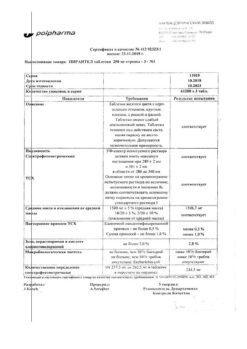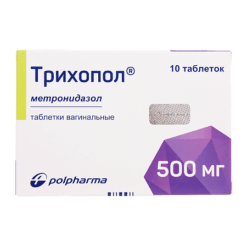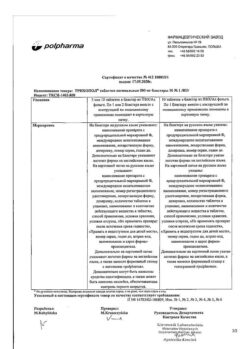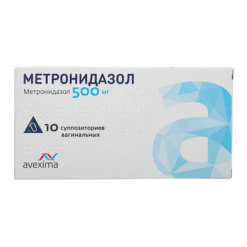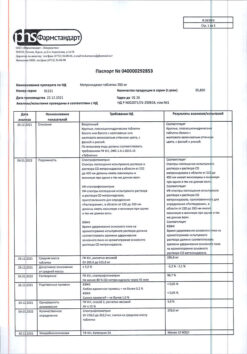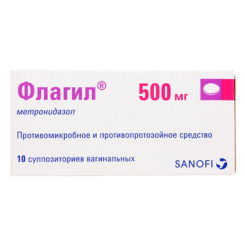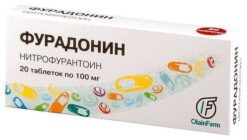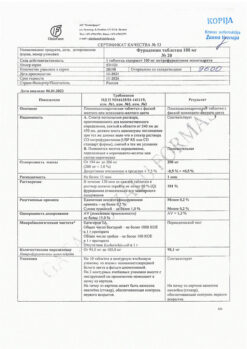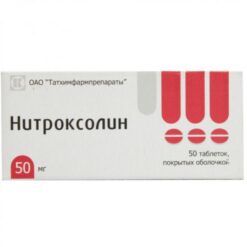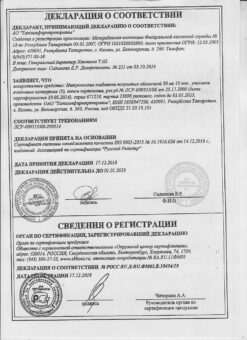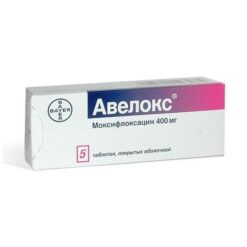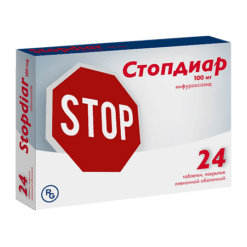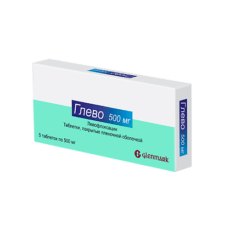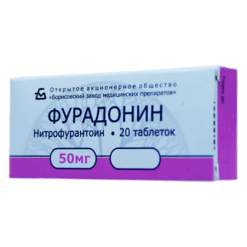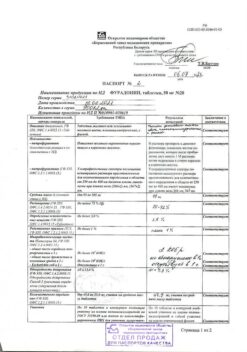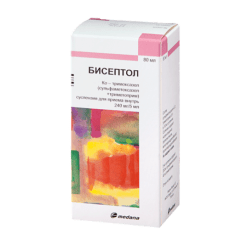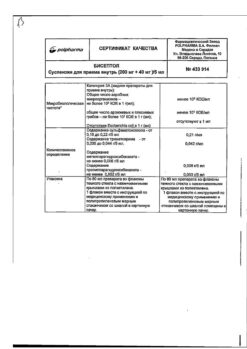No products in the cart.
Metronidazole, 500 mg/100 ml 100 ml
€0.79 €0.66
Description
Urethritis, Skin infections, Vaginitis, Amebiasis and giardiasis, Lung inflammation (pneumonia), Female genital infections, Trichomoniasis, Urinary tract infections
Indications
Indications
Protozoal infections: extraintestinal amebiasis (including amoebic liver abscess), intestinal amebiasis (amoebic dysentery), trichomoniasis; infections caused by Bacteroides spp. (including Bacteroides fragilis, Bacteroides ovatus, Bacteroides thetaiotaomicron, Bacteroides distasonis, Bacteroides vulgatus): infections of bones and joints, infections of the central nervous system (including meningitis, brain abscess), bacterial endocarditis, pneumonia, empyema and lung abscess, sepsis; infections caused by Clostridium spp., Peptococcus niger, Peptostreptococcus spp.: infections of the abdominal cavity (peritonitis, liver abscess), infections of the pelvic organs (endometritis, abscess of the fallopian tubes and ovaries, infections of the vaginal vault); pseudomembranous colitis associated with antibiotic use; gastritis or duodenal ulcer associated with Helicobacter pylori (as part of complex therapy); prevention of postoperative complications (especially after interventions on the colon, pararectal area, appendectomy, as well as after gynecological operations).
Pharmacological effect
Pharmacological effect
Pharmacotherapeutic group: Antimicrobial and antiprotozoal agent
Pharmacological action
Antiprotozoal agent with antibacterial activity, a derivative of 5-nitroimidazole. The mechanism of action is the biochemical reduction of the 5-nitro group of metronidazole by intracellular transport proteins of anaerobic microorganisms and protozoa. The reduced 5-nitro group of metronidazole interacts with the DNA of microbial cells, inhibiting the synthesis of nucleic acids, which leads to the death of microorganisms.
Active against Trichomonas vaginalis, Entamoeba hystolitica, as well as gram-negative anaerobes Bacteroides spp. (including Bacteroides fragilis, Bacteroides ovatus, Bacteroides distasonis, Bacteroides thetaiotaomicron, Bacteroides vulgatus), Fusobacterium spp. and some gram-positive anaerobes (susceptible strains of Eubacterium spp., Clostridium spp., Peptococcus niger, Peptostreptococcus spp.). The MIC for these strains is 0.125-6.25 μg/ml. In combination with amoxicillin, it is active against Helicobacter pylori (amoxicillin suppresses the development of resistance to metronidazole).
Aerobic microorganisms and facultative anaerobes are insensitive to metronidazole, but in the presence of mixed flora (aerobes and anaerobes), metronidazole acts synergistically with antibiotics effective against common aerobes.
Pharmacokinetics
With intravenous administration of 500 mg over 20 minutes, Cmax in blood serum after 1 hour is 35.2 mcg/ml. The concentration of metronidazole in the blood serum after 4 hours is 33.9 mcg/ml, after 8 hours – 25.7 mcg/ml; Cmin upon subsequent administration is 18 mcg/ml. Tmax – 30-60 minutes, therapeutic concentration is maintained for 6-8 hours. With normal bile formation, the concentration of metronidazole in bile after intravenous administration can significantly exceed the concentration in plasma.
Binding to blood proteins is insignificant and does not exceed 10-20%. Metronidazole quickly penetrates into tissues (lungs, kidneys, liver, skin, bile, cerebrospinal fluid, saliva, seminal fluid, vaginal secretions), breast milk and passes through the placental barrier.
About 30-60% of metronidazole is metabolized by hydroxylation, oxidation and glucuronidation. The main metabolite (2-oxymetronidazole) also has antiprotozoal and antimicrobial effects.
40-70% of metronidazole is excreted by the kidneys (unchanged – about 35% of the dose taken). T1/2 – 8-10 hours
Special instructions
Special instructions
Since the simultaneous use of metronidazole with alcohol (ethanol) may have an effect similar to that of disulfiram (skin hyperemia, flushing of the skin, vomiting, tachycardia), patients should be warned that during treatment and for at least one day after stopping the use of metronidazole they should not drink alcoholic beverages or medications containing ethanol.
The indications for long-term use of metronidazole should be carefully weighed and long-term use should be avoided unless strictly indicated. If, in the presence of strict indications, metronidazole is used for a longer period than is usually recommended, treatment should be carried out under the monitoring of hematological parameters (especially leukocytes) and adverse reactions, such as peripheral or central neuropathy (paresthesia, ataxia, dizziness, convulsions), if they occur, treatment should be discontinued.
When treating trichomonas vaginitis in women and trichomonas urethritis in men, it is necessary to abstain from sexual intercourse. Simultaneous treatment of sexual partners is mandatory. Treatment should not be stopped during menstruation. After treatment for trichomoniasis, control tests should be carried out during 3 consecutive cycles before and after menstruation.
Metronidazole should be used with caution in patients with hepatic encephalopathy or in patients with acute or chronic diseases of the central or peripheral nervous system due to the possible risk of neurological deterioration.
Severe hepatotoxicity/acute liver failure (including fatal cases that occurred very rapidly after initiation of treatment) has been reported in patients with Cockayne syndrome when treated with systemic metronidazole. In this category of patients, metronidazole should be prescribed only after a careful assessment of the benefit/risk ratio and only in the absence of alternative treatment.
Liver function tests should be performed before the start of treatment, during therapy and after its completion until liver function tests reach normal values, or until the initial values of these indicators are achieved. If liver function indicators are significantly exceeded during treatment, then use of the drug should be discontinued.
Patients with Cockayne syndrome should be advised to immediately report the development of any symptoms of potential liver damage to their physician and discontinue use of metronidazole.
Severe bullous skin reactions, such as Stevens-Johnson syndrome, toxic epidermal necrolysis, or acute generalized exanthematous pustulosis, have been reported following the use of metronidazole. If symptoms or signs of these diseases develop, treatment with the drug should be stopped immediately.
It must be taken into account that metronidazole can immobilize treponemes, which leads to a false-positive Nelson test.
Long-term use of metronidazole must be carefully justified due to possible mutagenicity and carcinogenicity.
Impact on the ability to drive vehicles and machinery
During the period of using metronidazole, it is advisable to refrain from performing potentially hazardous types of work that require increased concentration and speed of psychomotor reactions.
Active ingredient
Active ingredient
Metronidazole
Composition
Composition
Active substance: metronidazole
Pregnancy
Pregnancy
Contraindicated for use during pregnancy and breastfeeding.
Contraindications
Contraindications
Hypersensitivity to metronidazole, other nitroimidazole derivatives, imidazoles; organic lesions of the central nervous system (including epilepsy); leukopenia (including history); liver failure (if the drug is prescribed in high doses); pregnancy, breastfeeding period.
With caution
Hepatic encephalopathy, acute and chronic diseases of the peripheral and central nervous system (risk of worsening neurological symptoms), renal failure.
Side Effects
Side Effects
From the digestive system: epigastric pain, nausea, vomiting, diarrhea; inflammation of the oral mucosa (glossitis, stomatitis), taste disturbances (“metallic” taste in the mouth), decreased appetite, anorexia, dry oral mucosa, constipation; pancreatitis (reversible cases); discoloration of the tongue/”coated” tongue (due to excessive growth of fungal microflora).
From the immune system: angioedema, anaphylactic shock.
From the nervous system: peripheral sensory neuropathy; headache, cramps, dizziness. The development of encephalopathy (for example, confusion) and subacute cerebellar syndrome (impaired coordination and synergism of movements, ataxia, dysarthria, gait disturbances, nystagmus and tremor), which reverse after discontinuation of metronidazole, have been reported; aseptic meningitis.
From the mental side: psychotic disorders, including confusion, hallucinations; depression, insomnia, irritability, increased excitability.
From the organ of vision: transient visual disturbances, such as diplopia, myopia, blurred vision, decreased visual acuity, impaired color perception; Optic neuritis.
Hearing and labyrinthine disorders: hearing impairment/hearing loss (including sensorineural deafness); tinnitus.
From the hematopoietic system: agranulocytosis, leukopenia, neutropenia, thrombocytopenia.
From the liver and biliary tract: increased activity of liver enzymes (AST and ALT, alkaline phosphatase), development of cholestatic or mixed hepatitis, hepatocellular liver damage, sometimes accompanied by jaundice. Cases of liver failure requiring liver transplantation have been observed in patients treated with metronidazole in combination with other antibiotics.
From the skin and subcutaneous tissues: rash, itching, flushing of the skin, skin hyperemia, urticaria; pustular skin rash; acute generalized exanthematous pustulosis; fixed drug rash; Stevens-Johnson syndrome, toxic epidermal necrolysis.
From the urinary system: urine may turn brownish-reddish in color, due to the presence of a water-soluble metabolite of metronidazole in the urine; dysuria, polyuria, cystitis, urinary incontinence, candidiasis.
From laboratory parameters and instrumental studies: flattening of the T wave on the ECG.
General reactions: fever, nasal congestion, arthralgia, weakness.
Interaction
Interaction
The development of psychotic reactions has been reported in patients receiving concomitant metronidazole and disulfiram (the interval between the use of these drugs should be at least 2 weeks).
When used simultaneously with ethanol, disulfiram-like reactions may occur (hyperemia of the skin, flushing of the skin, vomiting, tachycardia).
When used simultaneously with indirect anticoagulants (warfarin), there is an increased anticoagulant effect and an increased risk of bleeding associated with a decrease in the hepatic metabolism of indirect anticoagulants, which can lead to an increase in prothrombin time. In the case of simultaneous use of metronidazole and indirect anticoagulants, more frequent monitoring of prothrombin time is required and, if necessary, dose adjustment of anticoagulants.
With the simultaneous use of metronidazole with lithium preparations, the concentration of the latter in the blood plasma may increase. When used simultaneously, the concentrations of lithium, creatinine and electrolytes in the blood plasma should be monitored.
With simultaneous use of metronidazole with cyclosporine, the concentration of cyclosporine in the blood plasma may increase. If simultaneous use of metronidazole and cyclosporine is necessary, the concentrations of cyclosporine and creatinine in the blood plasma should be monitored.
Cimetidine inhibits the metabolism of metronidazole, which may lead to an increase in its concentration in the blood plasma and an increased risk of side effects.
The simultaneous use of metronidazole with drugs that induce microsomal oxidation isoenzymes in the liver (phenobarbital, phenytoin) can accelerate the elimination of metronidazole, resulting in a decrease in its concentration in the blood plasma.
Metronidazole reduces the clearance of fluorouracil, leading to increased toxicity.
Metronidazole increases the concentration of busulfan in the blood plasma, which can lead to the development of severe toxic effects of busulfan.
It is not recommended to use metronidazole with non-depolarizing muscle relaxants (vecuronium bromide).
Sulfonamides enhance the antimicrobial effect of metronidazole.
Concomitant use of mebendazole and metronidazole should be avoided.
Simultaneous administration of metronidazole with other solutions containing sodium salts may lead to sodium retention in the body.
In laboratory studies during the use of metronidazole, difficulties may arise in determining the activity of AST, ALT, LDH, and triglyceride concentrations.
Manufacturer
Manufacturer
Elfa JSC NPC, Russia
Additional information
| Manufacturer | Elfa ZAO, Russia |
|---|---|
| Medication form | solution for infusion |
| Brand | Elfa ZAO |
Other forms…
Related products
Buy Metronidazole, 500 mg/100 ml 100 ml with delivery to USA, UK, Europe and over 120 other countries.



